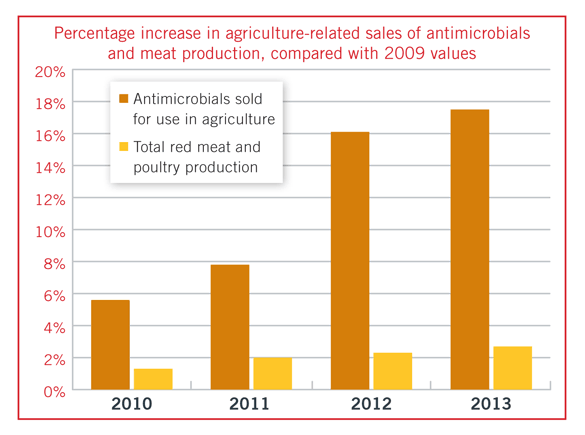Antimicrobial sales outpace meat production
Agriculture-related sales of antimicrobials rose one-sixth in five years, including a one-fifth rise in sales of antimicrobials considered medically important.
While those rises outpaced growth in meat, dairy, and egg production over the same period, federal officials, academics, and agriculture and drug industry advocates cautioned against assuming that changes in sales necessarily reflect changes in use.
Megan Bensette, a spokeswoman for the Food and Drug Administration, said the agency wants to collect more information on how antimicrobials are used in livestock, in part, to explain the change in antimicrobial sales. She also noted that the amounts in the sales data could differ from amounts used, and she cited as an example drugs bought in anticipation of disease outbreaks that never hit a herd.
FDA data indicate that, from 2009-2013, agriculture-related sales of antimicrobials rose 17 percent and included a 20 percent increase in sales of medically important drugs.
Department of Agriculture data show that meat production increased 2.6 percent during that same period. Dairy production rose 6 percent, although the dairy cow population was flat, according to USDA Economic Research Service data. Egg production went up the highest amount, still only a 9 percent increase.
Dr. Michael D. Apley, a professor of production medicine and clinical pharmacology at Kansas State University, said detailed data on antimicrobial administration to individual livestock species would provide opportunities to evaluate connections between use and disease trends. Lacking that information, he would feel irresponsible in guessing at causes for changes.
Detailed information also could improve our understanding of the meaning of changes in drug resistance and enhance our response to those changes, he said. For example, he said drug resistance prevalence could be addressed in a hospital system where resistance increased, rather than through regional or national interventions.
Betsy Booren, vice president of scientific affairs for the North American Meat Institute, provided a similar statement that the report’s meaning was difficult to interpret because the data do not indicate what amounts of each drug were administered to each animal species or why those drugs were used.

Possible causes vary
Ron Phillips, vice president of legislative and public affairs for the Animal Health Institute, said weather, animal population changes, and disease threats and outbreaks are, along with meat production, among the variables affecting antimicrobial use. One or a few factors cannot be considered to be responsible for changes in sales, he said.
“Nor is there a correlation between antibiotic sales and public health impact,” he said. “Too many people are focusing on sales as an indicator of public health risk—which it is not.”
Most of the rises in antimicrobial sales occurred in 2010 and 2012, when sales rose 5.6 percent and 7.7 percent, respectively.
James E. Pettigrew, PhD, professor emeritus of animal science at the University of Illinois, said he was surprised the FDA figures showed increased antimicrobial sales. His work with livestock industries has indicated to him that antimicrobial usage had been declining over the past decade, with an accelerated decline in recent years.
Dr. Pettigrew noted that antimicrobial use fluctuates with disease prevalence. For example, while porcine reproductive and respiratory syndrome is caused by a virus, it is an immune system disease that makes pigs more susceptible to secondary infections. He noted that there have been spikes in the prevalence of the disease in recent years.

Dr. Harry O. Snelson, communications director for the American Association of Swine Veterinarians, said secondary bacterial infections can follow not just PRRS but also other viral diseases such as influenza and infection with the porcine epidemic diarrhea virus that was first discovered in the U.S. in April 2013. The types of infections vary by farms, but some of the more common bacterial causes include Haemophilus parasuis and Streptococcus spp.
Dr. Snelson also noted that the data include some drug uses approved for companion animals. The FDA has indicated that a small portion of drug volumes included in its drug sales reports could have been used in pet medicine.
Uses changing in 2016
Booren said the meat institute supports efforts by the FDA to end growth-promotion uses of certain antimicrobials and increase veterinarian oversight, noting that nearly all data in the report came from sales before the FDA published its new guidance documents on antimicrobial use.
In December 2013, FDA announced in a guidance document that the agency was giving drug companies three years to end production uses of antimicrobials important for human medicine and to implement veterinarian oversight over remaining uses of those drugs. All affected companies have agreed to the changes, but agency officials have warned they could start administrative proceedings against any who fail to comply.
Bensette said sales of affected antimicrobials are expected to decline with the elimination of many production uses. But she said those uses could have had therapeutic benefits, which would explain reports from other countries of increases in therapeutic antimicrobial administration following elimination of production uses.
“We will continue our efforts to slow the progression of antimicrobial resistance by ensuring that remaining therapeutic uses are as judicious as possible,” she said.
Dr. Apley said his work with regulators, legislators, and people in food industries has helped him understand the sometimes competing desires to better know how and where antimicrobials are used in agriculture, protect anonymity during data collection, and know how drug use data will be used in connection with drug resistance data.
“One of my messages to my friends in the food industry is ‘Yes, it is necessary to get more detailed information, otherwise everything lives or dies together,’” he said. He explained that he is concerned that, without access to more detailed data, legislators, regulators, and retailers could require reductions in, or elimination of, all antimicrobial uses for prevention and control.
Related JAVMA links:
Changes coming in antimicrobial use, availability (Jan. 1, 2015)